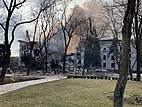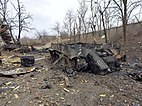
A | B | C | D | E | F | G | H | CH | I | J | K | L | M | N | O | P | Q | R | S | T | U | V | W | X | Y | Z | 0 | 1 | 2 | 3 | 4 | 5 | 6 | 7 | 8 | 9
| Eastern Ukraine campaign | |||||||
|---|---|---|---|---|---|---|---|
| Part of the Russian invasion of Ukraine | |||||||
Clockwise from top left:
| |||||||
| |||||||
| Belligerents | |||||||
| Commanders and leaders | |||||||
|
|
| ||||||
| Units involved | |||||||
| See order of battle | See order of battle | ||||||
| Strength | |||||||
|
38,000+ soldiers (late March 2022)[2][3][4] 50,000–62,000 soldiers (early April 2022)[5] 10,000–20,000 mercenaries (per European officials, early April 2022)[6][7][8] 300–500 Syrian and Libyan mercenaries (per ISW, early April 2022)[9] |
125,000 soldiers (in eastern Ukraine)[10] 40,000–50,000 (as of the start of the Battle of Donbas)[11] | ||||||
Ukraine's easternmost oblasts, Donetsk, Luhansk, and Kharkiv, are the site of a theatre of operation in the ongoing Russian invasion of Ukraine.
The battle of Donbas was a major offensive in the eastern theatre that took place in mid-2022.[12] By the culmination of the offensive in July 2022, Russian forces and their separatist allies had captured the cities of Sievierodonetsk,[13] Lysychansk,[14] Rubizhne[15] and Izium.[16] However, in early September, Ukraine launched a major counteroffensive in the east, which recaptured the cities of Izium, Balakliia, Kupiansk, Sviatohirsk[17] and the strategic city of Lyman.[18] The counteroffensive stalled east of the Oskil river, and a campaign in eastern Kharkiv Oblast and western Luhansk Oblast has continued since.
In the winter of 2022–2023, Russia focused on capturing the city of Bakhmut, largely destroying the city in one of the bloodiest battles of the war. Russia claimed to have fully captured Bakhmut in May 2023 amid ongoing Ukrainian counterattacks on the city's outskirts. In June 2023, Ukraine launched another major counteroffensive across the entire frontline, capturing some Russian positions along Bakhmut's outskirts and in southwestern Donetsk Oblast. However, by November 2023, this counteroffensive had largely stalled in the east and Russia began counterattacking to recapture territory, gaining control of Avdiivka and Marinka in Donetsk Oblast by February 2024.[19][20]
Background
Sporadic fighting had been taking place since 2014 between Ukrainian forces and Russian-backed separatists from the Donetsk People's Republic during the war in Donbas.[citation needed]
Campaign
Initial Russian attacks (February–March 2022)
Kharkiv Oblast

On 24 February, after Russian President Vladimir Putin announced a "special military operation" in Ukraine, Russian forces crossed the Russia-Ukraine border and began advancing towards Kharkiv. Ukrainian soldiers were deployed to positions along key routes into the city, and residents began volunteering for military service within hours of the invasion.[21] A Russian missile struck the Chuhuiv air base,[22] which housed Bayraktar TB2 drones. According to open-source intelligence, the attack left damage to fuel storage areas and infrastructure.[23]
On 25 February, fierce fighting continued in the northern outskirts of Kharkiv, especially in the village of Tsyrkuny.[24] On 26 February, the governor of Kharkiv Oblast, Oleh Syniehubov, stated that the city of Kharkiv was still under Ukrainian control, and announced a curfew for the city.[25]
In the early morning of 27 February, a gas pipeline in Kharkiv was destroyed by Russian forces.[26] Russian light vehicles broke into the city,[27] with half of them reportedly destroyed by Ukrainian forces in ensuing fighting.[28] By the afternoon, Ukrainian officials stated that Kharkiv was still under Ukrainian control despite the overnight attack by Russian forces.[29][30] Meanwhile, Hennadiy Matsegora, the mayor of Kupiansk, agreed to hand over control of the city to Russian forces and accused Ukrainian forces of abandoning it when the invasion began.[31] He was later accused of treason by the Ukrainian Prosecutor General Iryna Venediktova.[32]
On 2 March, Russian paratroopers landed in Kharkiv during the early morning and started clashing with Ukrainian forces. Clashes also took place near a military hospital of the city as Russian paratroopers descended on it. Kharkiv Oblast's Police Chief Volodymyr Tymoshko later stated that the situation was under control.[33]
The Verkhovna Rada meanwhile stated that Russian shelling on Izium killed eight people.[34] Russian forces entered the town of Balakliia during the day.[35]
On 4 March, Ukrainian forces launched a counterattack in Kharkiv Oblast, reportedly pushing the Russian forces towards the Sumy Oblast, and reaching part of the Russia-Ukraine border.[36] By 7 March, Ukraine claimed to have retaken Chuhuiv near Kharkiv in a counter-attack overnight.[37] During the day, Ukraine also claimed to have killed Russian Maj. Gen. Vitaly Gerasimov, while also killing and wounding other senior Russian Army officers during a battle near Kharkiv.[38]
On 8 March, Ukraine stated that it had repelled an attack by Russian forces on Izium.[39]
Donetsk Oblast
On the morning of 25 February, Russian forces, along with allied separatists, advanced from territory controlled by the Donetsk People's Republic (DPR) towards Mariupol, encountering Ukrainian forces in Pavlopil.[40] The Ukrainians were victorious, destroying at least 20 Russian tanks.[41] In the evening, the Russian Navy began an amphibious assault 70 kilometers (43 miles) from Mariupol, along the coast of the Sea of Azov.[42][43] Russian forces bombarded Mariupol throughout 26 February; the city's mayor Vadym Boychenko claimed that schools and apartment buildings had been struck.[44]
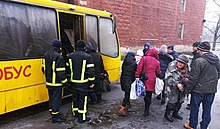
On the morning of 27 February, it was reported that a Russian tank column was quickly advancing towards Mariupol from DPR-held territory, but the attack was prevented by Ukrainian forces. Six Russian soldiers were captured.[45]
The same day, Donetsk Oblast governor Pavlo Kyrylenko said that Volnovakha was undergoing a humanitarian crisis, as Russian shelling had practically destroyed the entire city.[46]
On 1 March, Ukrainian forces began a counteroffensive toward Horlivka, which had been controlled by the DPR since 2014.[47][48]
On 2 March, separatist-held Donetsk had been under shelling for several days. Some neighborhoods had no electricity supply and there were burnt cars on the streets.[49]
Ukrainian official Oleksiy Arestovych stated that the Ukrainian forces went on the offensive for the first time during the war, advancing towards Horlivka.[50][51][52] Ihor Zhdanov later claimed that "there were reports" that a part of the city had been captured by Ukrainian forces.[53] According to Ukrainian reports, Ukraine's 95th Air Assault Brigade had begun attacking the city the previous day.[54]

Ukrainian authorities stated on 3 March that 34 civilians had been killed in Russian shelling in Mariupol in the previous 24 hours.[55]
On 5 March, a ceasefire was declared in Volnovakha to allow civilians to evacuate, but was later scuttled with Ukrainian officials blaming Russian shelling continuing during the evacuation process. They added that about 400 civilians were still able to leave the city. Russian President Vladimir Putin however blamed Ukrainian forces for the breakdown of the ceasefire agreement.[56][failed verification]
On 6 March, both sides blamed each other for the failure of a second attempt to evacuate civilians from Mariupol.[57]
On 9 March, a building acting as a maternity ward and children's hospital in Mariupol was bombed by the Russian Air Force at around 17:00, killing five civilians and injuring 17.[58]
On 11 March, the Russian Defence Ministry stated that the forces of the DPR had captured Volnovakha.[59] It also claimed that they had advanced 6 kilometres (3.7 mi) and had further tightened the siege of Mariupol. Videos later posted on social media showed Russian forces in many neighborhoods of Volnovakha.[60]
On 12 March, the Associated Press independently confirmed that Volnovakha had been captured by pro-Russian separatists and much of it had been destroyed in the fighting.[61] Pavlo Kyrylenko, the governor of Donetsk Oblast, stated that while the settlements of Nikolske, Manhush and Urzuf had been occupied by Russian troops, they had yet to capture any key cities, with the exception of Volnovakha.[62]
In the northern Donetsk Oblast, the Sviatohirsk Lavra monastery was bombed around 22:00 on 12 March, wounding 30 people and damaging the monastery.[63][64]
The Russian Defence Ministry stated on 13 March that Russian forces had captured the settlements of Nikolske, Blahodatne, Volodymyrivka and Pavlivka in Donetsk Oblast, in an attempt to reach Velyka Novosilka.[65][66] The Ukrainian military stated that Russian forces had captured the settlements of Staromlynivka, Yevhenivka, Pavlivka and Yehorivka during the day.[67]
On 14 March, Donetsk was hit by a missile attack.[68][69] Denis Pushilin, the head of the Donetsk People's Republic, stated that they had shot down a Ukrainian Tochka-U missile fired on the city of Donetsk, but parts of the missile fell into the city centre, killing multiple civilians. The Russian Defense Ministry stated that 23 civilians were killed and 28 more wounded. However, the Ukrainian military denied conducting the attack and stated that it was "unmistakably a Russian rocket or another munition",[70] which was supported by an assessment of the Conflict Intelligence Team, an investigative journalism group.[71]
Ukrainian forces later said that Russian troops of the 336th Guards Naval Infantry Brigade and the 11th Guards Air Assault Brigade had tried to advance in the Donetsk Oblast at 17:00, but were repulsed with up to 100 soldiers killed and six of their vehicles being destroyed.[72]
On 20 March, Russian officials confirmed that Andrey Paliy, a deputy commander of the Black Sea Fleet, had been killed in Mariupol.[73]
Luhansk Oblast
On 24 February, the Ukrainian military said that Russian forces were attempting to cross the Siverskyi Donets River and penetrate the Ukrainian defensive line amid heavy clashes for Shchastia and Stanytsia Luhanska.[74] By 27 February, Luhansk Oblast governor Serhiy Haidai acknowledged that February that both cities had come under Russian occupation, and had been practically destroyed by Russian shelling.[46]
On 25 February, the Ukrainian military claimed that its artillery had inflicted damage on a Russian column preparing to cross the Aidar River near Starobilsk, forcing the Russians to withdraw.[75]

On 2 March, forces of the Luhansk People's Republic and Russian troops captured Novoaidar, taking over a base of Ukraine's 79th Brigade.[76] Further north, a Russian convoy of 60 vehicles entered Starobilsk through the fields near the villages of Shulhynka, Omelkove, and Khvorostianivka. Inside the city, the Russians were confronted by protesting locals waving Ukrainian flags and singing the Ukrainian national anthem. The column continued in the direction of Svatove.[77]
The next day, civilians carrying Ukrainian flags protested against Russian troops in Svatove.[78] After talks with locals, the soldiers withdrew from the town.[78][79]
Haidai stated on 6 March that fighting was taking place on the outskirts of Lysychansk, Sievierodonetsk and Rubizhne, as Ukrainian units had fallen back to a new front line in order to avoid encirclement or a Russian breakthrough. He added that Ukrainian forces had lost control of Svatove, Starobilsk and Novopskov, though Russian forces were not deployed in the cities in large numbers. He also said that Popasna and Hirske were being continuously shelled.[80]
On 8 March, Ukrainian officials stated that ten civilians had been killed and eight wounded in shelling on Severodonetsk during the day.[58] Haidai, meanwhile, stated that Russian forces had occupied 70 percent of Luhansk Oblast.[81]
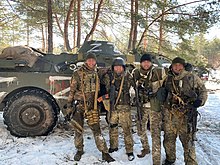
On 12 March, Ukrainian forces confirmed the death of Colonel Valery Hudz, the commander of the Ukrainian 24th Mechanized Brigade while fighting on the Luhansk frontline.[82] Ukrainian officials accused Russia of using white phosphorus munitions on the town of Popasna, located in the Luhansk Oblast, during the night of 12–13 March.[63]

On 15 March, Haidai stated that four civilians were killed due to Russian shelling of a hospital, a care facility for children with visual impairments, and three schools in Rubizhne.[83]
On 22 March, the head of the LPR, Leonid Pasechnik, claimed that "almost 80% of the territory" of the Luhansk region was under separatist control, with Popasna, Lysychansk, Rubizhne, Severodonetsk and Kreminna remaining Ukrainian-held. He noted that the situation in the battlefield was "stably tense" and that units of the People's Militia of the LPR were striving to capture Popasna and Rubizhne.[84]
Battle of Donbas (April–September 2022)
April 2022

On 25 March, the Russian defence ministry stated that it was prepared to begin a second phase of military operations with the aim of occupying major Ukrainian cities in eastern Ukraine. According to the ministry, Russian-backed separatists were in control of 93% of Luhansk Oblast and 54% of Donetsk Oblast.[85]
After Russia abandoned its offensive to capture Kyiv, it shifted its attention to eastern and southern Ukraine. The Russian military began redeploying units from northern Ukraine to the east, but many of these troops appeared to be nearly combat-ineffective due to heavy losses. However, Russia still amassed tens of thousands of troops, declaring its aim to fully capture the Donetsk and Luhansk Oblasts.[86][87] It managed to secure Izium on 1 April, although heavy fighting continued around the settlement over the next few days.[88] According to local authorities 80% of Izium's residential buildings were destroyed in the battle.[89] On 3 April, according to the Ukrainian government, two Russian soldiers died and 28 others were hospitalized after Ukrainian civilians handed out poisoned cakes to soldiers of the Russian 3rd Motor Rifle Division in Izium.[90][91]
Russia and the pro-Russian separatists continued to besiege Mariupol, where they made little progress. However, Russian troops managed to divide the Ukrainian holdouts in Mariupol into two or three pockets on 10 April.[92] At the same time, Russia made concentrated efforts to conquer the strategically important cities of Sievierodonetsk, Popasna, and Rubizhne. It launched repeated attacks on these locations from 10 April.[86][92][87] Russia made little progress in these attacks,[87] and Ukraine claimed that it had inflicted a heavy defeat on the Russian 60th Independent Motorized Infantry Brigade [ru; uk] on 11 April.[86] In nearby Kreminna, Ukraine's 128th Brigade claimed to have pushed Russian forces 6-10 kilometers away from the city.[93]
To support the operations aimed at Sievierodonetsk, Popasna, and Rubizhne, Russia made a push south of Izium toward Barvinkove and Sloviansk. Ukraine responded by shifting more units to hold off the Russians at Izium. At the same time, Russia attacked around Kharkiv to pin down local Ukrainian forces.[92][86][87] Russia had made only limited gains at Izium by 12 April, but more Russian forces continued to arrive, to reinforce the offensive.[87]
On 13 April, it was reported that Russia was attempting to assemble a force large enough to outnumber the Ukrainian soldiers in eastern Ukraine by five times, in an attempt to finally win a decisive victory in the Donbas.[94] On 16 April, Russia warned the remaining defenders of Mariupol to surrender; the Ukrainians ignored the demand.[95][96] On 18 April, Ukraine launched counter-attacks, and retook several small towns and villages near Kharkiv and Izium.[97]
Also on 18 April, Zelenskyy announced that the "battle for Donbas" had begun, as Russian forces launched an offensive across a 300-mile front. According to Russian officials, 1,260 military targets were hit by rockets and artillery.[98][99][100][101] The initial Russian bombardment focused on Rubizhne, Popasna, and Marinka.[97]
On the same day, it was reported that Russian and LNR troops had entered the city of Kreminna, capturing it after a few hours of clashes with the Ukrainian Army.[102][103] LNR commander Mikhail Kishchik was killed in this battle.[104] Over the next days, Russia gained little territory despite attacks all across the frontline. Facing heavy Ukrainian resistance, the Russian and separatist forces were able to advance into parts of Rubizhne, Popasna, and Sievierodonetsk. Some reports also suggested that fighting in Kreminna was still ongoing.[9][105][106] On 21 April, the Russians claimed to have killed over 4,000 Ukrainian troops in Mariupol, and to have captured a further 1,478.[107] By 23 April, Ukrainian counter-attacks had reportedly further stalled the Russian advance.[108]
In the following days, Russia continued its attempts to break through the Ukrainian defenses, possibly in an aim to encircle the Izium-Donetsk City salient. Fighting was concentrated at Sievierodonetsk, Rubizhne, Popasna, Marinka, Kharkiv, and Izium.[109][110][111][112] Russia, the LPR, and the DPR made limited gains, capturing a number of villages and the towns of Popivka, Pischane, Zhytlivka, and Kreminna.[110][111] However, their overall advance was slow, and stalled in most areas of the frontline. Ukraine also mounted a growing number of counter-attacks at Izium and Kharkiv, gradually expelling Russian forces from a number of settlements.[113][112][114]
First Ukrainian Kharkiv counteroffensive and the recapture of Mariupol and Sievierodonetsk (May–September 2022)
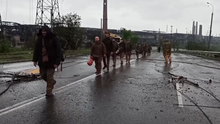
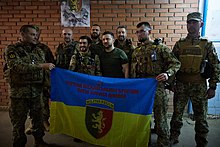

On 30 April, Ukraine launched a large-scale counter-offensive at Kharkiv, retaking the city's suburbs and several more towns over the following days.[114][115][116][117][118]
By 4 May, Russian forces had been pushed back to such a distance that most of their artillery could no longer strike Kharkiv.[115] Meanwhile, Russian and DPR/LPR separatist forces continued to attempt to break through Ukrainian defenses at Izium and the Donetsk-Luhansk frontline.[118][116][119][117] On 6 May, the ISW described a Ukrainian counteroffensive "along a broad arc" near Kharkiv, reporting that Ukraine had recaptured "several villages," including Tsyrkuny, Peremoha and part of Cherkaski Tyshky.[120] The ISW also reported that Ukraine "may successfully push Russian forces out of artillery range in Kharkiv in the coming days."[120]
On 7 May, Russian forces destroyed several bridges in an attempt to slow down the Ukrainian counter-offensive at Kharkiv. On the same day, Russia and separatist troops also captured Popasna.[121] Following the capture of Popasna, Russia began attempting to encircle Sievierodonetsk.[122][123]
On 7 May, it was reported that Ukrainian forces had successfully pushed back Russian forces stationed around Kharkiv, with the city getting further out of range for Russian forces.[124] The same day, Ukrainian forces also reported retaking five villages northeast of Kharkiv.[125] Quoting a Ukrainian official, The New York Times said that the battle for Kharkiv was not over, but that at the moment, Ukraine was dominating, and that Russian troops were destroying bridges as they were retreating.[126] On 11 May, Ukrainian forces claimed to have recaptured four settlements. The counteroffensive had the potential to bring Ukrainian forces within several kilometers of the Russian border.[127]
On 10 May, Ukraine made further gains on the Kharkiv front, forcing Russia to redeploy forces from the Izium front to the north.[128]
In addition, Ukrainian artillery destroyed an entire Russian battalion tactical group attempting a river crossing in the battle of the Siverskyi Donets.[129] Meanwhile, Russia and the DPR attempted to cement their occupation in eastern Ukraine through political and economic means, likely in an attempt to integrate these areas into the existing separatist republics or establish new ones.[130] On the other side, Ukrainian civilians began organizing resistance movements.[110] As Ukrainian forces retook territory around Kharkiv, local civilian collaborators fled to Russia.[115]
On 12 May, Russian forces seized Rubizhne and the nearby town of Voevodivka.[131][132] Heavy fighting subsequently took place at the village of Dovhenke south of Izium.[133] On 13 May, it was reported that Russia had decided to withdraw its forces from Kharkiv Oblast.[134] On 14 May, the ISW reported that "Ukraine thus appears to have won the battle of Kharkiv."[135] The Mayor of Kharkiv said to the BBC: "There was no shelling in the city for the last five days. There was only one attempt from Russians to hit the city with a missile rocket near Kharkiv airport, but the missile was eliminated by Ukrainian Air Defence."[136]
Russia continued its attempts to encircle Sievierodonetsk and began to focus on cutting the highway at Bakhmut.[133][137] By 14 May, the Ukrainians claimed to have killed over 6,000 Russian soldiers in Mariupol. They also claimed to have destroyed 78 tanks and 100 other armored vehicles.[138] On 15 May, Ukrainian forces reached the border near Kharkiv, while continuing to push back Russian and LPR units.[137] On the following day, the siege of Mariupol was formally concluded as the Ukrainian military personnel in the city's Azovstal agreed to gradually evacuate and surrender to the Russian forces.[137][139] Four days later, the Russians announced that they had taken an additional 2,439 Ukrainians prisoners in Mariupol, bringing the total number captured during the siege to 3,917.[140] In addition, it was reported that unrest – including public protests – was growing among pro-Russian collaborators and separatists in eastern Ukraine, as they accused Russian forces of corruption, incompetence, and forced mobilizations.[137]
Over the following days, Russia made little to no progress at the Izium frontline, but captured some territory around Popasna and Sievierodonetsk, increasingly threatening Sievierodonetsk and Lysychansk with encirclement.[141] Russia also intensified air and artillery strikes targeting Ukrainian positions around Izium, possibly to prepare for renewed attacks.[142][143] At the northern front,[where?] Russia and separatist forces retook a few villages and fortified their positions to stall the Ukrainian counter-offensive.[143][142]
After the Ukrainian counteroffensive, Russian forces were driven back to defensive positions, some of which were within miles of the Russia-Ukraine international border. Despite this, they continued to shell various Kharkiv suburbs, as well as the city proper, killing numerous civilians and wounding dozens more. Skirmishes along the Russia–Ukraine border in the area of northeastern Ukraine continued between Russian and Ukrainian forces beyond 14 May.[144][145][146]
On 20 May, Russian forces again shelled several villages in the Kharkiv district, including the city of Kharkiv itself, using BM-21 Grad, BM-27 Uragan and BM-30 Smerch multiple rocket launchers.[147][148] On 21 May, the Ukrainian police confirmed the recovery of the bodies of six military officials, including a Russian colonel, in the settlement of Zolochiv.[149]
On 22 May, the Russian forces made minimal progress in eastern Ukraine. New reports confirmed that Russian troops had occupied Rubizhne in the northern Kharkiv Oblast on May 19. In northern Kharkiv, Russian forces brought in reinforcements to maintain their positions on the west bank of the Seversky Donets River, instead of retreating across the river to use it as a defensive position, to prevent further Ukrainian advances north or east that could jeopardize Russian communication lines along the Izium axis.[150] On 24 May, Russian forces attempted to retake Ternova in northern Kharkiv Oblast.[151]
On 23 May, Russian forces took control of Lyman and attacked Avdiivka.[142][152] On 24 May, Russian forces attacked from Popasna with the aim of cutting off Bakhmut, Lysychansk and Sievierodonetsk, gaining some ground. Ukrainian forces made a controlled withdrawal southwest of Popasna to strengthen their defensive position at Bakhmut. Russia subsequently captured Svitlodarsk.[152][153]
Around this time, Ukrainian defence adviser Yuriy Sak publicly demanded more multiple launch rocket systems to reinforce Ukrainian artillery capabilities.[154] On 31 May, the United States announced a military aid package that included precision rocket systems with a range of 80 km.[155]
After a fierce month-long battle that ruined much of the city, Russian and LPR forces captured Sievierodonetsk along the Siverskyi Donets river on 25 June.[156] On the same day, the battle of Lysychansk began, which also saw a Russian victory on 2 July. The following day Russian and LPR forces declared full control of the entire Luhansk region.[157] On 4 July, The Guardian reported that after the capture of the Luhansk oblast, that Russian invasion troops would continue their invasion into the adjacent Donetsk oblast to attack the cities of Sloviansk and Bakhmut. The Russian military declared an "operational pause" to rest and replenish front line forces in Luhansk.[158] On 9 July, a Russian rocket attack on two residential buildings in Chasiv Yar killed at least 48 people.[159]
On 25–26 July, after Russia's operational pause concluded, Russian sources reported that the towns of Berestove, Novoluhanske, and the nearby Vuhlehirska Power Station had been captured. The Institute for the Study of War (ISW) suggested Ukrainian defenders likely conducted a deliberate withdrawal from the area.[160][161][162]
On 13 August, the Russian defence ministry said its forces had captured the village of Udy, northwest of Kharkiv.[163]
The Deputy Chief of the Main Operational Directorate of Ukraine's General Staff, Oleksiy Hromov, alleged on 1 September that Russian president Vladimir Putin had ordered Russian forces to capture the entirety of Donetsk Oblast by 15 September via a renewed offensive. Hromov further alleged that Russia was going to rotate its recently established 3rd Army Corps to the Donetsk front. A senior U.S. defense official dismissed the purported deployment of the "older, unfit, and ill-trained" 3rd Army Corps personnel as being unable to increase Russia's overall combat power in Ukraine.[164]
Second Ukrainian Kharkiv counteroffensive (September–October 2022)


On 6 September 2022, Ukrainian forces began a surprise counter-offensive on the Kharkiv front that resulted in Russian forces retreating over 1,000 square kilometres (390 sq mi) east.[165] On 4 September, Zelenskyy announced the liberation of a village in Donetsk Oblast. Ukrainian authorities released a video of their forces entering Ozerne.[166] On 8 September, Ukrainian forces recaptured more than 20 settlements in Kharkiv Oblast, including the towns of Balakliia and Shevchenkove and 'penetrated Russian defense positions up to 50 km' according to the General Staff of the Armed Forces of Ukraine. On the same day, a representative of the Russian occupation authorities announced that the 'defense of Kupiansk had begun' and that additional Russian forces were on their way to support the effort, suggesting that Ukrainian elements were close to the town.[167][168][169]
On 9 September, Ukrainian forces reached the outskirts of Kupiansk and destroyed the main bridge over the Oskil river in the city center, limiting the ability of the Russian Army to retreat or to bring in reinforcements.[170][171] In the morning of 10 September, Ukrainian soldiers posted pictures of the Ukrainian flag being raised in front of the town hall.[172] Also on 10 September, Izium, a central command post of the Russians in the region, fell to Ukrainian forces, "with thousands of Russian soldiers abandoning ammunition stockpiles and equipment as they fled."[172] On 11 September, it was reported that the Ukrainians had retaken Velykyi Burluk in Kharkiv Oblast, just 15 miles (24 km) from the border with Russia.[173] Russia responded with missile strikes on civilian areas and on non-military infrastructure facilities like power stations.[174] The Russian Ministry of Defense then formally announced Russian forces' withdrawal from the majority of Kharkiv Oblast on September 11,[175] with Russia only controlling parts of the region on the east bank of the Oskil River.[176]
By October 2022, Ukrainian forces had retaken several villages and towns in northern Luhansk and northern Donetsk, including Yatskivka, Novoliubivka, Nevske, Hrekivka, Novoiehorivka, Nadiya, Andriivka, and Stelmakhivka, among others.[177][178][179] On 1 October, Ukrainian forces entered Lyman after a short siege.[180] Russian forces had fallen back to the P-66 highway near the Kharkiv-Luhansk Oblast border, anchored by the settlements of Svatove and Kreminna, the first city to be taken during the battle of Donbas. On 2–3 October, Ukrainian forces began attacking towards Kreminna and Svatove in an attempt to break the Russian front line along the P-66 in northern Luhansk.[citation needed]
First Russian winter campaign (November 2022–May 2023)
Early winter (November–December 2022)

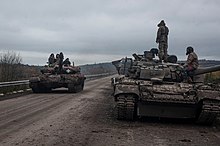
Russian forces launched a renewed offensive in southern and northern Donetsk Oblast in early November,[181] with Russian troops intensifying their attempts to break through Ukrainian defensive lines in Bakhmut, Soledar, Pavlivka, and Vuhledar.[182] On 11 November, DPR forces were reported to have entered Pavlivka.[183] Russian forces, including Wagner Group PMC fighters, overran defensive lines south of Bakhmut in late November, claiming to have captured the settlements of Kurdiumivka, Ozarianivka, Zelenopillia, and Andriivka by 30 November, while clashes in Opytne continued.[184][185]
By December 2022, the Donbas was the site of the fiercest fighting in Ukraine. Russian and Ukrainian forces funneled reinforcements from other fronts to the Bakhmut–Soledar axis while Ukraine's eastern counteroffensive largely stalled along the Lyman–Kreminna–Svatove axis.[186] Russia spent much of the month consolidating defense lines along the Kreminna–Svatove front, seeking to prevent a Ukrainian breakthrough to the P-66 highway; the Ukrainians, including the 92nd Mechanized Brigade, attempted intermittent local counterattacks across the line of contact while repelling many local Russian assaults.[187] The Kreminna–Svatove line became a defensive flashpoint for Russia, which reportedly reinforced the area with two battalions of T-90 tanks and a few BMPT armored fighting vehicles, and reportedly mobilized elements of the 144th Guards Motor Rifle Division and 8th Guards Combined Arms Army.[187][188] Both the Russians and Ukrainians claimed to be conducting offensive operations along this front line and repelling local enemy assaults; on 10 December, the Russian defense ministry said it was making new advances east of Lyman[189] while the Institute for the Study of War assessed that Ukraine "likely" controlled the contested front line settlement of Chervonopopivka as of 22 December.[190]
Meanwhile, multiple Russian sources reported that Wagner fighters had captured and were clearing Yakovlivka, located along Soledar's northeastern flank, by 7 December.[191] The Russians also claimed to have shot down a Ukrainian Mi-8 helicopter in Yakovlivka on 8 December.[192] Ukraine was reportedly rotating in fresh units in the Donbas by mid–December, particularly from the Kherson front. The 57th Motorized Brigade, 36th Marine Brigade, and the 46th Airmobile Brigade reinforced the Bakhmut front alongside the 24th Mechanized Brigade, relieving the 93rd, which had defended Bakhmut and Soledar for months. The 28th Brigade reportedly rotated to Kostiantynivka and the 18th Marine Infantry Battalion, 35th Marine Brigade reinforced Nevelske and Pervomaiske.[193][better source needed]
Heavy clashes along the Bakhmut–Soledar axis continued by 10 December, typified by grueling trench warfare, drone warfare, artillery duels, and minor ground assaults amid freezing temperatures. Zelenskyy accused Russia of having "destroyed" Bakhmut, saying there was "no residential space that hasn't been damaged by shelling for a long time." On 10 December, the Ukrainian General Staff said more than 20 settlements were bombarded in fighting in the Bakhmut area alone.[189][194] Ukrainian paratroopers of the 71st Separate Huntsman Brigade reported repelling a Russian "sabotage and reconnaissance group" with mortar fire near Bakhmut, "eliminating" at least two attackers.[195] On 16 December, Wagner PMC forces reportedly finished clearing Yakovlivka, further threatening Soledar's northeastern flank.[196]
In southern and western Donetsk Oblast, the battle of Marinka continued,[190] with DPR president Denis Pushilin claiming on 15 December that 80 percent of the city had been captured amid ongoing heavy urban combat.[197] Russia also continued demolition and reconstruction projects in Mariupol, reportedly seeking to turn the ruined city into a garrison city. Observers accused Russia of using the rebuilding efforts to cover up and destroy evidence of war crimes in Mariupol, particularly the March 2022 Mariupol theatre airstrike.[198][199]
Russian regular, separatist, and Wagner PMC forces continued attempts to break defense lines on Bakhmut's southern and eastern flanks via small probing attacks; Wagner fighters spearheaded ground assaults into the city and its satellite suburbs, each of which Ukraine had turned into a stronghold. Media, government officials, and eyewitnesses described the fighting in Bakhmut as a "meat grinder" as both Ukrainian and Russian troops reportedly suffered heavy casualties daily with negligible changes on the front line.[191][200]
The ISW assessed that the pace of Russia's Donbas advances in November and December was roughly equivalent to the pace in October. According to the ISW, Russian forces gained a total of 192 sq km in the Bakhmut sector between 1 October and 20 December.[201] Footage posted online by a Russian journalist confirmed Russian forces had captured Andriivka, 10 km south of Bakhmut, by 22 December. The journalist claimed that Wagner fighters were fighting near Klishchiivka, where Ukraine reportedly had established strong defensive positions. Meanwhile, Ukraine continued to hold the northern half of Opytne and the western half of Marinka.[190] On 26 December, Zelenskyy referred to Ukraine's situation in the Donbas as "difficult," saying the Russians were "using all the resources available to them ... to squeeze out at least some advance."[202] Ukraine's Eastern Military Command reported that the Bakhmut area was shelled 225 times on 26 December alone.[203]
Russian breakthroughs (December 2022–March 2023)
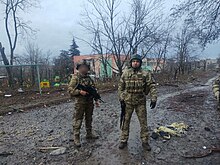

Russian forces intensified their encirclement attempts of Bakhmut in the winter, as Wagner broke through Ukrainian defense lines in the salt-mining town of Soledar on 27 December, capturing Bakhmutske.[204] Soledar itself was taken by 16 January 2023, degrading Bakhmut's northeastern defensive flanks.[205][206] The recapture of Soledar allowed Russian forces, spearheaded by Wagner fighters, to further flank Bakhmut from the northeastern direction and assert control over a portion of the T0513 highway towards Siversk.[207] Defences along Bakhmut's northern flank collapsed as the Ukrainians withdrew from Krasna Hora on 11 February.[208] Wagner advanced 2-3 kilometers to the west of Blahodatne, capturing the area near the main M-03 highway leading into Bakhmut. Both the UK Defence Ministry and Ukraine's governor of Donetsk Pavlo Kyrylenko said the Russians were attempting a pincer movement of Bakhmut, enveloping the city from multiple directions and establishing fire control over most Ukrainian supply routes into it.[209][210][211]
In mid-January, a battle took place in Vodiane. On January 15, around 9-10 in the morning, elements of the DPR's 1st Slovyanska Separate Mechanized Brigade attacked eastern Vodiane from a frozen-over flooded area west of Opytne. These elements were not supported by artillery. At 12pm, a convoy of eight to nine Russian BMP-2s heading towards Ukrainian-controlled west Vodiane was hit by Ukrainian fire, injuring 70% of the soldiers involved, according to the Russian commander of the attack. Two T-72Bs then approached the town, but were destroyed. A third and final attack took place in the afternoon, when some BMPs attempted to drive close to the bridge between Vodiane and Opytne (which had been destroyed during the fighting), but were also destroyed by artillery. There were also attacks on Sieverne, west of Avdiivka.[212] On 10 February 2023, Russian fighters in Vodiane claimed that there is "not a single living creature in the town" from the destruction.[213] A group of Russian soldiers from the "Storm" detachment from Kaliningrad released a video in March 2023, claiming they were suffering large losses while fighting in Vodiane.[214]
By 22 February, Russian units had crossed the M-03 and began assaulting Yahidne and Berkhivka, northwest of Bakhmut, with the Ukrainians claiming to have repelled the assaults amid heavy fighting.[215] Wagner claimed to have captured both villages by 26 February, however Ukraine's general staff said Russian assaults remained "unsuccessful" amid heavy shelling.[216][217] Geolocated footage on 4 March showed Russian troops were advancing along both banks of the Berkhivka reservoir located about 4 kilometers northwest of Bakhmut, on the approaches to Khromove and Dubovo-Vasylivka villages, respectively.[218][219] On 7 March, Ukraine ceded eastern Bakhmut to Russian forces, retreating west of the Bakhmutka river.[220][221][222] Wagner claimed to have advanced along the M-03 and expanded the buffer zone north and west of Bakhmut, capturing the villages of Dubovo-Vasylivka and Zaliznianske by 16 March,[223][224] however Ukrainian defenders stalled the advance along this axis by 19 March, repelling assaults on Orikhovo-Vasylivka, Bohdanivka, and Khromove villages.[225][226][227][228]
In early March 2023, Zelenskyy referred to the ongoing fighting in the Donbas as "painful and difficult".[229] Clashes around Avdiivka escalated in February and March, as the Ukrainians claimed Russian forces had begun an attempted encirclement effort of the city.[230] Russian forces increased the amount of airstrikes in the area as ground units advanced towards Avdiivka's outskirts from the north and northeast, capturing Krasnohorivka (9 km north of Avdiivka) and Vesele (7 km north of Avdiivka) by 21 March.[231][232] Further to the south, the grinding battle for Marinka had reduced the city to "post-apocalyptic" ruins as Russian ground units made minimal gains amid fierce urban combat with Ukrainian defenders.[233] DPR leader Denis Pushilin claimed Ukraine was continuously transferring reserves to Marinka.[234][235]
Zdroj:https://en.wikipedia.org?pojem=Horlivka_offensiveText je dostupný za podmienok Creative Commons Attribution/Share-Alike License 3.0 Unported; prípadne za ďalších podmienok. Podrobnejšie informácie nájdete na stránke Podmienky použitia.
Antropológia
Aplikované vedy
Bibliometria
Dejiny vedy
Encyklopédie
Filozofia vedy
Forenzné vedy
Humanitné vedy
Knižničná veda
Kryogenika
Kryptológia
Kulturológia
Literárna veda
Medzidisciplinárne oblasti
Metódy kvantitatívnej analýzy
Metavedy
Metodika
Text je dostupný za podmienok Creative
Commons Attribution/Share-Alike License 3.0 Unported; prípadne za ďalších
podmienok.
Podrobnejšie informácie nájdete na stránke Podmienky
použitia.
www.astronomia.sk | www.biologia.sk | www.botanika.sk | www.dejiny.sk | www.economy.sk | www.elektrotechnika.sk | www.estetika.sk | www.farmakologia.sk | www.filozofia.sk | Fyzika | www.futurologia.sk | www.genetika.sk | www.chemia.sk | www.lingvistika.sk | www.politologia.sk | www.psychologia.sk | www.sexuologia.sk | www.sociologia.sk | www.veda.sk I www.zoologia.sk


